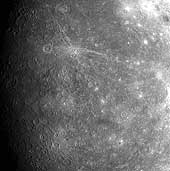|
COMETS EARTH JUPITER KUIPER BELT MARS MERCURY METEORITES NEPTUNE OORT CLOUD PLUTO SATURN SOLAR SYSTEM SPACE SUN URANUS VENUS ORDER PRINTS
PHOTO CATEGORIES SCIENCEVIEWS AMERICAN INDIAN AMPHIBIANS BIRDS BUGS FINE ART FOSSILS THE ISLANDS HISTORICAL PHOTOS MAMMALS OTHER PARKS PLANTS RELIGIOUS REPTILES SCIENCEVIEWS PRINTS
|
Related Documents
Download Options
Two weeks ago, on January 14, 2008, MESSENGER became the first spacecraft to see the side of Mercury shown in this image. The first image transmitted back to Earth following the flyby of Mercury, and then released to the web within hours, shows the historic first look at the previously unseen side. This image, taken by the Wide Angle Camera (WAC) of the Mercury Dual Imaging System (MDIS), shows a closer view of much of that territory. Just above and to the left of center of this image is a small crater with a pronounced set of bright rays extending across Mercury's surface away from the crater. Bright rays are commonly made in a crater-forming explosion when an asteroid strikes the surface of an airless body like the Moon or Mercury. But rays fade with time as tiny meteoroids and particles from the solar wind strike the surface and darken the rays. The prominence of these rays implies that the small crater at the center of the ray pattern formed comparatively recently. This image is one in a planned set of 99. Nine different views of Mercury were snapped in this set to create a mosaic pattern with images in 3 rows and 3 columns. The WAC is equipped with 11 narrow-band color filters, and each of the 9 different views was acquired through all 11 filters. This image was taken in filter 7, which is sensitive to light near the red end of the visible spectrum (750 nm), and shows features as small as about 6 kilometers (4 miles) in size. The MESSENGER team is studying this previously unseen side of Mercury in detail to map and identify new geologic features and to construct the planetís geological history. Mission Elapsed Time (MET) of image: 108827618 Credit: NASA/Johns Hopkins University Applied Physics Laboratory/Carnegie Institution of Washington |
